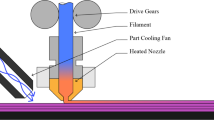Abstract
This paper presents a simple and straightforward, expeditious and accurate approach towards tolerance charting. Its simplicity in logic and approach allows a newcomer in this field to quickly develop expertise in process tolerance charting. The approach is used in conjunction with linear optimisation software, LINDO, to determine the optimal dimensions and tolerances for the part that is being processed. An example is given to illustrate the approach.
Similar content being viewed by others
References
L. E. Farmer and G. A. Harris, “Change of datum of the dimensions on engineering design drawings”, International Journal of Machine Tool Design and Research, 24(4), pp. 267–275, 1984.
R. S. Ahluwalia and A. V. Karolin, “CATC — A computer aided tolerance control system”, Journal of Manufacturing Systems, 32, pp. 153–160, 1986.
D. Fainguelernt, D. Weill and P. Bourdet, “Computer aided tolerancing and dimensioning in process planning”, Annals CIRP, 35(1), pp. 381–386, 1986.
X. Q. Tang and B. J. Davies, “Computer aided dimensional planning”, International Journal of Production Research, 26(2), pp. 283–297, 1988.
S. A. Irani, R. O. Mittal and E. A. Lehtihet, “Tolerance chart optimization”, International Journal of Production Research, 27(9), pp. 1531–1552, 1989.
K. Whybrew, G. A. Britton, D. F. Robinson and Y. Sermsuti-Anuwat, “A graphic theoretic approach to tolerance charting”, International Journal of Advanced Manufacturing Technology, 5(2), pp. 175–183, 1990.
B. K. A. Ngoi, “Applying linear programming to tolerance chart balancing”, International Journal of Advanced Manufacturing Technology, 7(2), pp. 187–192, 1992.
B. K. A. Ngoi and C. K. Chua, “A matrix approach to tolerance charting”, International Journal of Advanced Manufacturing Technology, 8(3), pp. 175–181, 1993.
B. K. A. Ngoi and S. L. Fang, “Computer aided tolerance charting”, International Journal of Production Research, 32(8), pp. 1939–1954, 1994.
B. K. A. Ngoi and C. K. Tan, “Computer aided tolerance charting — a ‘black box’ approach”, International Journal of Production Research, 33(4), pp. 1117–1134, 1995.
B. K. A. Ngoi and M. S. Seow, “A window approach for tolerance charting”, International Journal of Production Research, 34(4), pp. 1093–1107, 1995.
B. K. A. Ngoi and C. S. Tan, “Graphical approach to tolerance charting — ‘Maze Chart’ method”, International Journal of Advanced Manufacturing Technology, 13(4). pp. 282–289, 1997.
D. F. Eary and J. E. Johnson, Process Engineering for Manufacturing, Prentice-Hall, 1962.
Author information
Authors and Affiliations
Rights and permissions
About this article
Cite this article
Ngoi, B.K.A., Cheong, K.C. The apparent path tracing approach to tolerance charting. Int J Adv Manuf Technol 14, 580–587 (1998). https://doi.org/10.1007/BF01301702
Issue Date:
DOI: https://doi.org/10.1007/BF01301702




